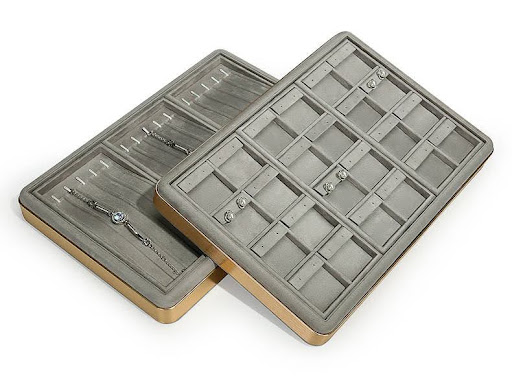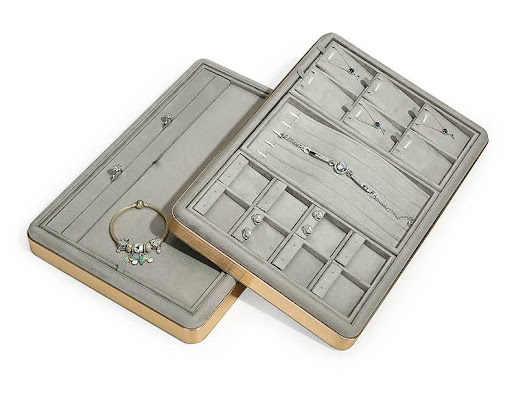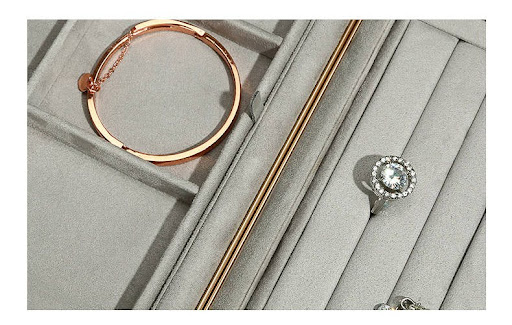How to Clean and Maintain Your Jewelry Tray

Proper jewelry trays cleaning and maintenance will keep it looking like new, extend its lifespan, and protect any delicate pieces stored inside. The key is tailoring your routine according to the base material and lining material of your tray–different materials require specific care so as to avoid damage (for instance water can ruin velvet while harsh cleaners scratch acrylic). Below is a step-by-step breakdown for common materials as well as tips to minimize long-term wear and tear.Part 1: Cleaning Your Jewelry Tray (by Material) Begin by emplacing the tray entirely–remove all jewelry from it and store it separately (use a soft cloth to briefly wipe down each piece, to reduce grime transference back onto the tray). Next, follow these material-specific steps:

A. Lining Materials Are More Delicate Parts
As your jewelry directly touches the lining (velvet, suede or felt), avoid harsh chemicals or excess moisture as much as possible.
Lining Material Cleaning Steps and What to Avoid Velvet
- Dust first: Use a soft-bristled brush (such as a makeup or small paintbrush ) with soft bristles (e.g. a makeup brush or small paintbrush ) to carefully and safely sweep away surface dust – brush in the same direction as velvet nap to avoid matting of velvet nap.
- Spot Clean Stains: For spot-cleaning of stains, dip a clean white cloth into lukewarm water mixed with a small drop of mild detergent such as baby shampoo. Blot lightly against any stain you encounter without rubbing since this pushes dirt deeper.
- Dry: Allow the area to air-dry completely (avoiding direct sunlight, which fades color) before using the tray again. – Waterlogging causes velvet to shrink or lose softness)
; Bleach, alcohol or strong detergents discolor fibers or damage their fibers).
Suede/Felt
1.To remove dust, use a suede brush; for felt, use a dry microfiber cloth.
- Stains: When dealing with fresh spills or set stains, immediately blot them using a dry cloth (do not rub). For set stains, mix a drop of mild soap in water then soak a cloth dipped into it then dab gently dabbing before blotting up using dry cloth dipped into mild soap solution before finally blotting up using another dry cloth before blotting up again before blotting later blotting later with dry microfiber cloth before using dry cloth to blot again before blotting up with another dry cloth then blotting with another dry cloth then blot / cloth then blot dry cloth then blot with another dry cloth then use an additional method will work.
- Refresh: For felt that’s flattened, gently fluff with your fingers or soft brush to refresh it. Too much moisture (suede warps; felt pills).
Scrubbing (ruin suede’s texture or surface of felt). Leather (Genuine/Faux)
1.Wipe down: Use a dry microfiber cloth to wipe down surfaces to remove dust or fingerprints.
- Remove Stains: For genuine leather furniture, a leather cleaner (following product instructions) should be used; on faux leather materials however, use lukewarm water + mild soap on a damp cloth and wipe off immediately to dry.
Condition (Genuine leather only): To keep genuine leather soft and prevent cracking, every 3-6 months apply a small amount of leather conditioner. – Harsh chemicals (alcohol or acetone) that strip leather’s finish; Letting water sit (causes water spots).
Microfiber: How to Dust: Either lightly shake the area with your hand or wipe down with a dry cloth.
1 Deep Clean: Most microfiber linings can be machine washed using cold water, mild detergent, and the gentle cycle for maximum cleaning efficiency. To air-dry (to protect fibers), air drying should always be preferred over heating the material to high heat settings.
- Spot-clean: For spot stains, use a damp cloth and mild soap before air-drying. – Fabric softener coats microfibers to reduce their dust-trapping ability), while hot water or tumble drying hardens or shrinks microfiber.
- Base Materials: Structure and Stability
The base (acrylic, wood or metal) should be treated carefully to prevent scratches or discoloration from developing. Here are three steps for cleaning base material (acrylic, wood, metal) effectively:
1.Dust: To quickly and easily wipe away dust particles use a dry microfiber cloth instead of paper towels as these can leave scratches behind.
Remove Smudges: Combine a small amount of mild dish soap with warm water. Dip a soft cloth in this mixture, wipe gently over acrylic surfaces and dry immediately with another cloth.
Polish: If cloudiness exists, use an acrylic-specific polish (avoid glass cleaner, which contains ammonia that damages acrylic).
Avoid ammonia, vinegar or glass cleaner as they contain ammonia which causes clouding or cracking of acrylic surfaces; additionally they should avoid using abrasive sponges or scrub brushes as these will scratch the surface and may leave scars.
Wood
1.Dust: Use a dry microfiber cloth (avoid feather dusters as these spread dust).
- Clean: For sealed wood (such as jewelry tray bases), wipe with damp cloth using lukewarm water mixed with mild soap before drying immediately; however unfinished wood needs only dry cloth cleaning (water causes warping).
- Protect: Every 6-12 months, sealer wood should be coated with a thin layer of wood conditioner or beeswax to protect it against drying and fading caused by excess moisture – sealed wood may develop water spots; unfinished warps.
bleach cleaners or harsh cleaners (which strip its stain or sealant).

Metal
Dust: Use a dry cloth.
- Clean Tarnish (Brass/Copper): Combine equal parts lemon juice and baking soda to form a paste, rubbing with soft cloth before rinsing thoroughly with water and drying thoroughly afterwards.
- Shine (for gold/silver/rose gold): Use metal polish (such as silver polish for silver-plated bases) or use a damp cloth with mild soap added and dry immediately in order to avoid water spots. – Abrasive cleaners will scratch metal finishes.
Not treating tarnish (it spreads and damages metal over time).
Dust: Use a dry cloth. 2. Clean: For gentle stains, use a damp cloth with mild soap to wipe down the surface; dry off immediately afterwards. For tough spots, leave the soapy cloth sitting on them for one or two minutes before wiping clean. – Acetone or nail polish remover (melts or discolors plastic), Hot water (warps thin plastics).
Part Two: Long-Term Maintenance Tips (Prevent Wear & Tear) mes Just cleaning isn’t enough–these habits will keep your jewelry tray in top condition over the years:
Empty and clean your tray regularly: For best results, aim to empty and clean it once every 2-4 weeks (or more frequently if used daily), to prevent dust build-up that can penetrate velvet linings and become difficult to remove.

Protect against humidity: Avoid placing your tray near sinks in bathrooms as humidity can warp wood and metal components while fabric linings mildew quickly. If necessary, place a dehumidifier nearby if storing in humid areas.
Avoid Overloading: Avoid piling heavy jewelry (e.g., thick bracelets and large necklaces) onto one area in an attempt to reduce weight distribution evenly; this could stretch fabric linings, bend metal bases and crack acrylic. Use compartmentalized trays for evenly dispersion.
Handle with care: When moving a tray, lift from its base rather than from its edges in order to avoid bending or breaking it. For stackable trays, try not to stack more than 2-3 high as excessive weight could crush the bottom tray and damage its contents.
Store Your Tray Properly When not in Use: When not in use (e.g. a travel tray), cover it in soft cloth and store in a cool, dry drawer – avoid placing it near sharp objects that could scratch its base or lining as this could scratch or mar it.
By adhering to your jewelry trays materials and following these maintenance habits, you will keep it looking as good as new while safeguarding necklaces, rings and earrings from scratches or scrapes.





